
Information is powerful. And for SEOs, it can help inform, guide, and drive change. That’s why we’re always looking for more data from Google to better understand where traffic is coming from, what people are searching for, which elements in the search results are driving those clicks, and more. And that’s also why tools such as Google Search Console (GSC), Google Analytics, and a number of third-party tools are critically important for providing context to search traffic.
On that note, even though there are some outstanding third-party tools, we rely heavily on Google to provide that information. Third-party tools can be extremely helpful, but there’s nothing like getting your data directly from the belly of the beast.
Change Is Constant And So Are The SERPs, Chrome, and More
I recently wrote a post for my Search Engine Land column that demystified the metrics in Google Search Console (GSC). That included how Google calculates impressions, clicks, and position in the search results and how that translates to your reports. My column seemed to resonate with the SEO community, which supports the fact that we are all extremely interested (or maybe obsessed) about data from Google. It also underscores the point that we want to know exactly what we’re looking at in our reports.
So, data is one thing, but the correct interpretation of data is another. That leads me to the core point of this post – untrackable clicks from Google, often from new and interesting SERP features, Chrome, and feeds.
What Are Untrackable Clicks From Google?
Untrackable clicks are visits from SERP features, or Google’s ecosystem of Chrome and feeds, that don’t have specific reporting in Google Search Console (GSC) or Google Analytics. You can often see impressions and clicks for the query and page (if your content is ranking in Search), but the search feature isn’t trackable in Search Console (at least yet).
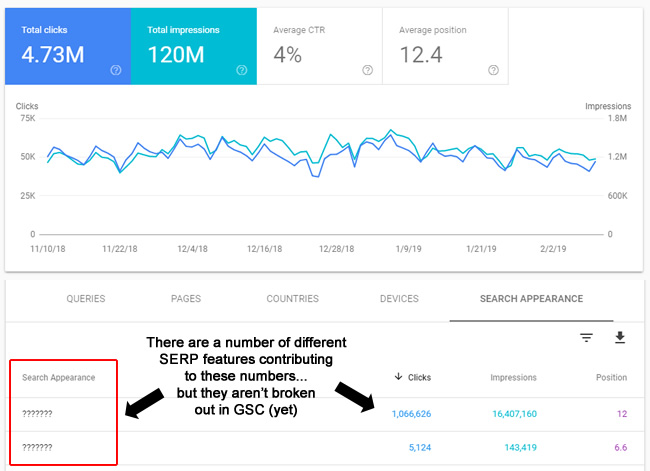
And for Google’s ecosystem beyond Search (like Chrome and Discover), they don’t have a logical place in GSC yet (and may never), and those visits can show up in Google analytics a number of ways (yet obviously don’t reveal which features they are coming from). It’s all a bit confusing…
Also, context is extremely important for SEOs and site owners when they are analyzing their organic search efforts. So, understanding when listings are ranking in certain SERP features, or within Google’s ecosystem, is important. Then you can better understand how users are getting to your content, analyze the content that’s ranking, and then craft strategies to potentially land more of those rankings.
Before we begin… the importance of posting feedback in GSC
Just to be clear, site owners and SEOs don’t have to sit around and twiddle their thumbs while untrackable clicks rack up in GSC. Collectively, we do have a voice. The Google Search Console team is a smart group of savvy Googlers that wants to provide the best functionality for site owners.
They have recently given us extremely powerful functionality in GSC like the index coverage reporting and the URL inspection tool, and I know they seek feedback from users about what they could add in the future.
So definitely post feedback in GSC when you see something wrong, if you have an idea for new functionality, etc. From what John Mueller has said many times, the team does receive and read your feedback and that feedback can help validate feedback they receive from other places. So, use the feedback form in GSC!
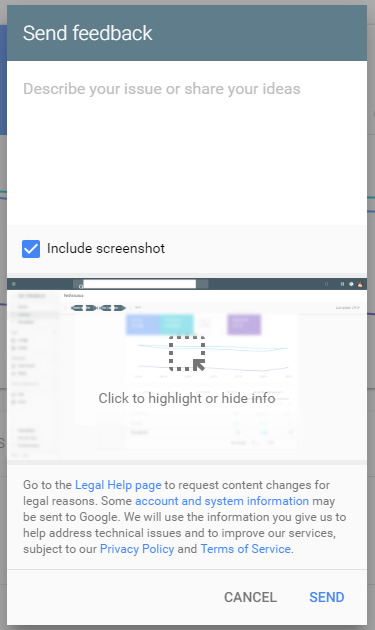
Below, I have provided a list of seven examples of untrackable clicks from Google (from the SERPs and from Google’s ecosystem of Chrome and Feeds). Note, I can’t cover every possible form of untrackable click in this post. The list will always be expanding based on innovations from Google… That said, I have provided seven of the top examples below.
Video Carousels and New “Video Packs”
The mobile SERPs are filled with carousels, which makes sense… Carousels provide a slick way to pack more listings into a single search result. One type of carousel that has taken off recently is the video carousel. They started booming in the SERPs in mid-2018 and are present for many queries now (some would argue they are present for too many queries, but that’s for another post).
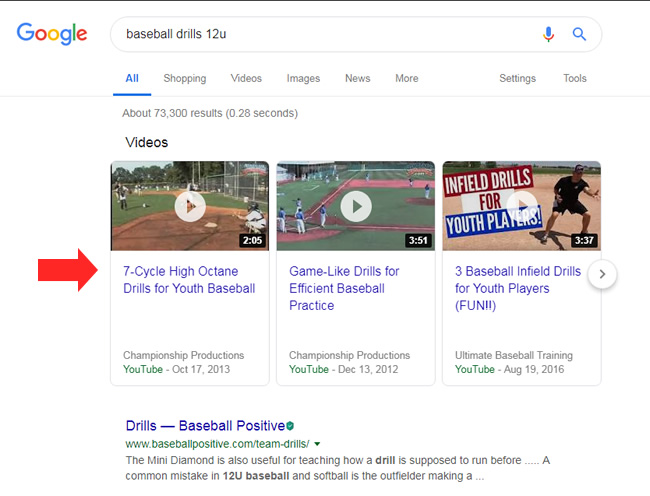
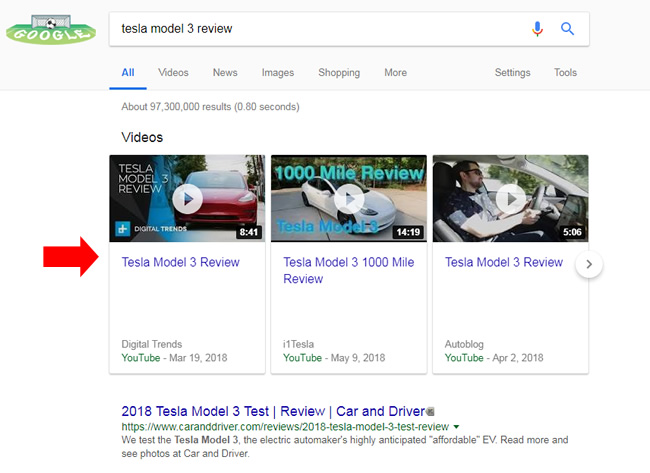
Also, I just noticed (and tweeted) that video packs are showing up in place of many carousels in the mobile search results (showing between 4 and 10 videos per block). That’s an interesting move and one you should definitely be aware of if video is important to your efforts.
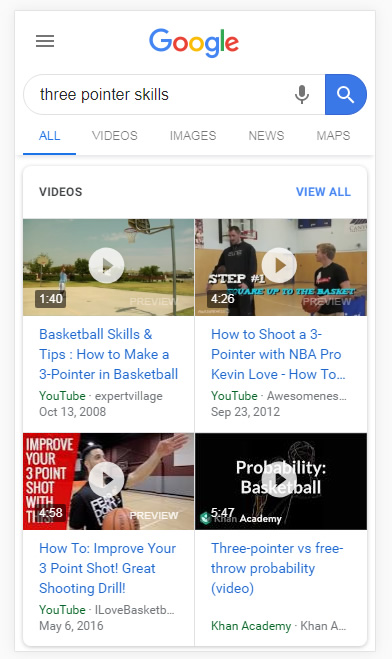
For now, there’s no specific reporting for video carousels or new video packs in Search Console. The “video” filter in GSC under Search Type will only show you rankings from the video tab in the SERPs (video search), and not video carousels or packs from the core search results (10 blue links).
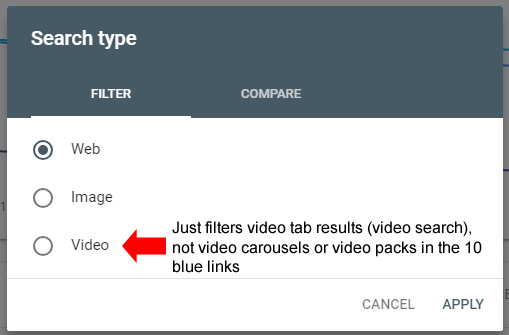
From a video carousel standpoint (which is blended into the SERPs), if a listing shows up in a video carousel, and it’s scrolled into view, then it will register an impression. But again, your listing needs to scroll into view for that to happen. And there’s no filter for video carousels in GSC, so the clicks and impressions show up just like any other clicks and impressions from organic search.
It would be incredible to know when certain urls were ranking in video carousels and then obviously drill into the queries that yielded those rankings.
From a tracking perspective, a video carousel filter would be very helpful. For example, in GSC’s performance reporting, you can currently filter AMP rich results and other rich results, but you can’t view video carousel data. I think based on the video carousel boom, a filter there would be extremely helpful. See a mockup below of what that could look like:
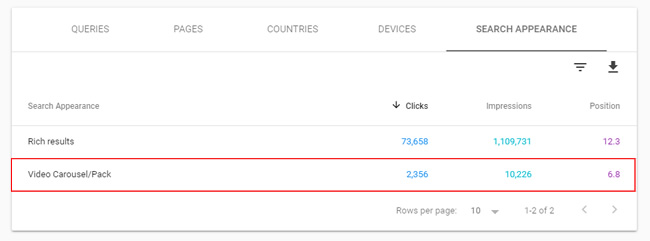
Discover Feed
Discover is a customized feed of news, information, articles, evergreen content, video, and more. It was previously called “the Google Feed” and you can find your Discover feed in the Google app and on the homepage of Google.com on your mobile device (when you are logged in). Google announced that 800M people now use Discover (as of September of 2018).
It’s important to note, that you don’t need to be in Google News to rank in Discover. Google is providing information based on your interests, sites you visited in the past, the topics you have selected to follow, entities you have selected to follow in the SERPs, and more. And it includes evergreen content that’s not new to the web, but might be new to you.

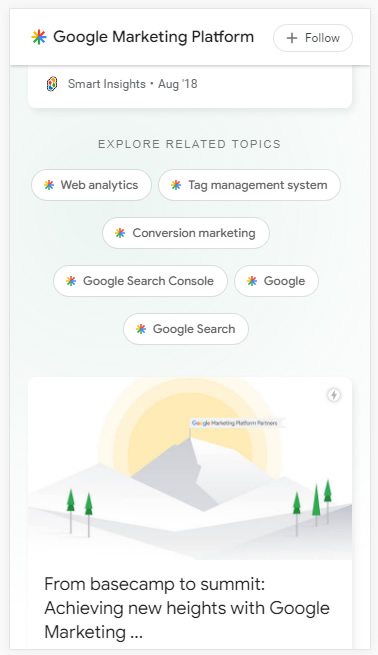
based on their interests.
Although many people are browsing Discover (some have even called it their new Instagram feed), and clicking through to articles from Discover, there’s currently no way to track that’s happening. It’s another form of untrackable click from across Google’s ecosystem.
For example, I’ve seen articles from various SEOs I know in my Discover feed, I’ve clicked through to those articles, but they unfortunately have no idea that happened. In Google Analytics, visits from Discover can show up as direct traffic, or they can be attributed to your first visit to the site (which could be organic search). So GA doesn’t really help here.
Understanding traffic in Discover would help SEOs understand when Google has decided to include their content in someone’s feed, how much traffic (or return traffic) they are getting via Discover feeds, and more. It’s not organic search traffic, but could be based on iniitial visits from organic search.
Therefore, some type of tracking in GSC would be incredible. Maybe there could be another report for Discover. Remember, over 800M people use Discover on a regular basis now… Here’s a quick mockup of a new section for Discover data:
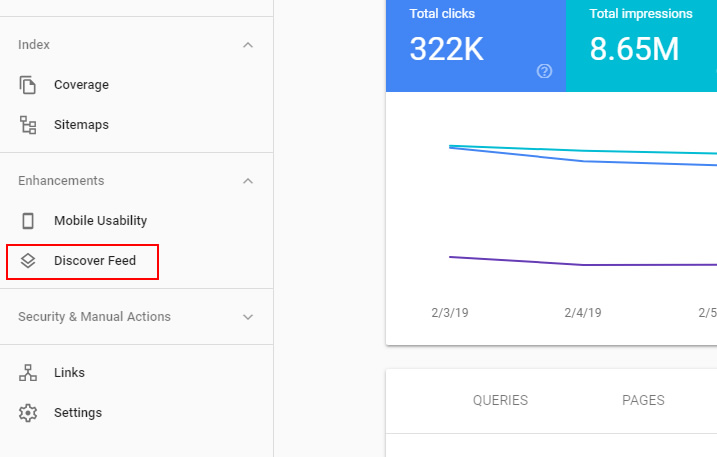
Discover Update: 2/16/19
After publishing this post, a reader posted a comment that he found a blank Discover report *in GSC now*. He pointed me to this tweet from JR Oakes as reference. So Google is actually testing performance reporting for Discover! There’s no data yet, but that’s still incredible news.
Note, Google has tested features like this before in GSC and never rolled them out. So, it’s possible this might not see the light of day. Time will tell. But needless to say, I was pretty excited to see it. And hey, my mockup above wasn’t that far-fetched! :)
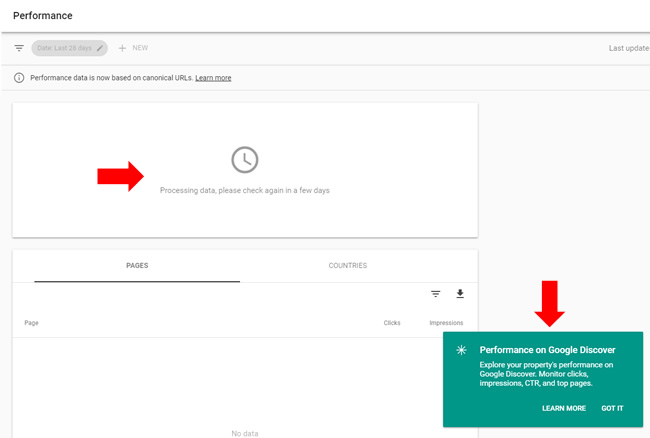
but it’s great to see this being tested.
Interesting finds
I call this the search feature nobody is talking about… yet it’s been popping up more and more recently. When searching Google, you will often see “interesting finds” in the mobile search results as a module containing either three or four articles (with thumbnails). Note, I just noticed three listings showing up versus four and will share more about that on Twitter soon. And if you are using AMP, those AMP urls will rank in the “interesting finds” SERP feature. Notice the AMP icon below for my listings.
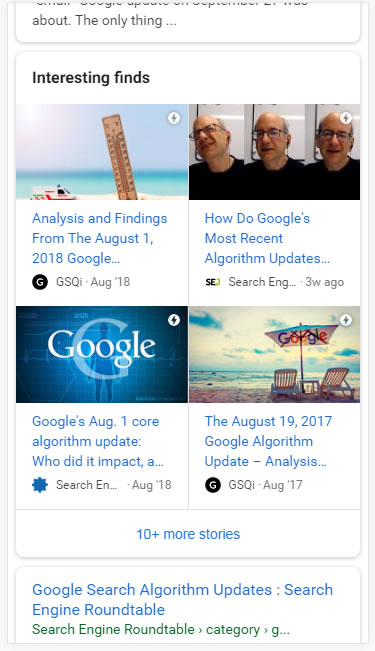
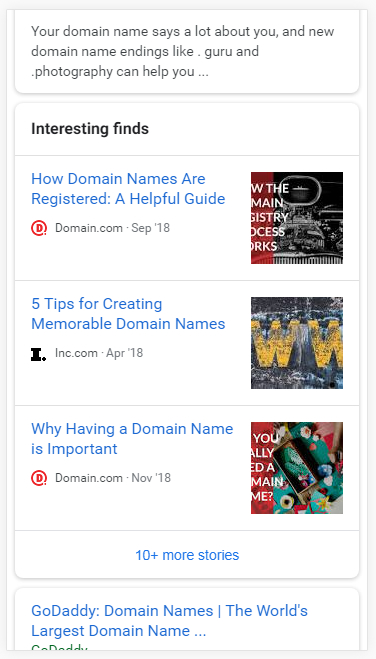
“Interesting finds” can also contain a link to ten more articles, which takes you to a Discover-like feed for the topic. It can really grab a user’s attention. That’s where you can see up to ten articles on the topic. And tying this to Discover, you can also follow the topic! Remember when I called this Google’s ecosystem?
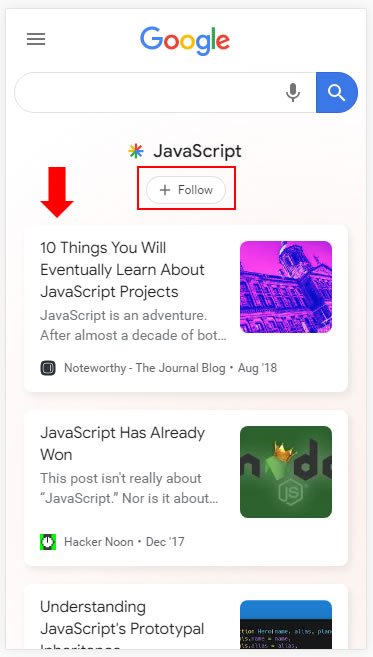
a follow button (for Discover).
The problem is that site owners have no idea users are coming from that SERP feature. The impression and click will show up just like any other listing in the 10 blue links. The position will be the position of the “interesting finds” block. And in Google Analytics, the visit will look like any other visit from Google organic.
From a tracking perspective, it would be optimal to know that your articles are ranking in “interesting finds” for a number of reasons. For example, since Google thinks enough of the content to surface it in the “interesting finds” module for a specific topic, it would be great to analyze that content to help refine your content strategy (and to possibly gain more “interesting finds”).
In addition, it would be great to know when an article drops out of “interesting finds”, which can yield a drop in impressions and clicks. If you can’t track that, then site owners and SEOs could think something else happened that cause the drop in traffic. And that can lead to a lot of confusion.
“More like this” or “Related Pages” in the Google Search App
I’ve been meaning to write a post dedicated to this feature, since I know many don’t realize that it can be driving traffic to their sites. When you’re in the Google search app and you visit a page, you can always click the “More like this” icon in the menu bar. The feature was moved to the top of the app last year, so it’s *sometimes* in a prominent location.
The reason I say sometimes is because I just noticed today that it moved again! Now it’s available when you scroll down a page (you’ll see a “View 10 related pages”, which you can pull up from the bottom of the viewport). See below:
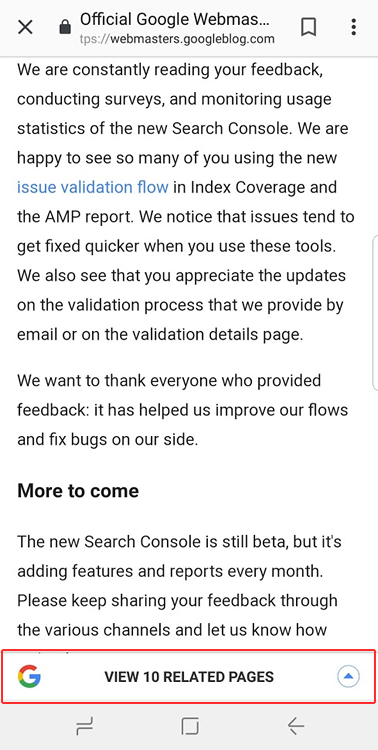
(when available at the bottom of an article)
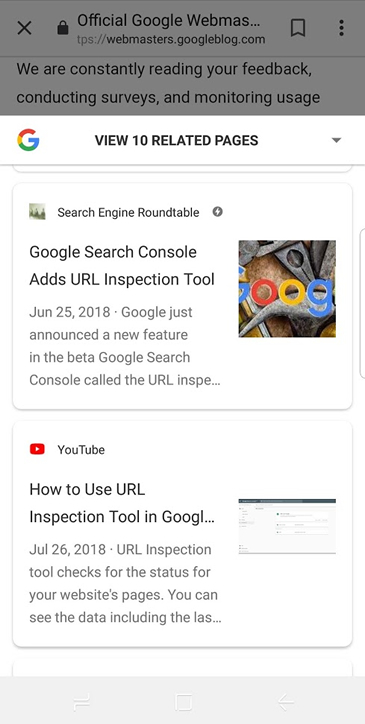
(pulled up from the bottom of the viewport).
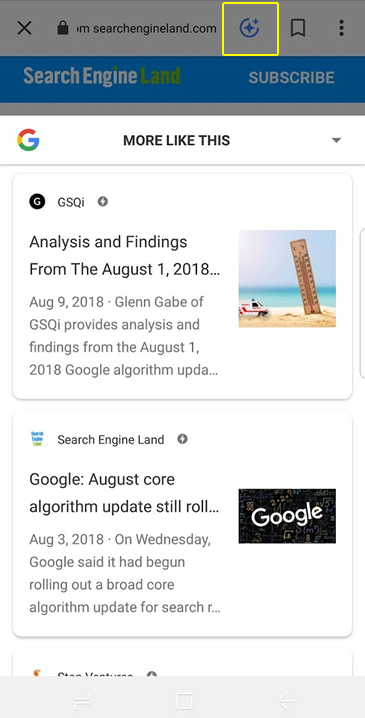
(via an icon at the top of the page)
When clicking that icon, or pulling up the related pages bar, you will see a list of links that Google believes are extremely relevant to the content at hand. It’s basically a form of “related articles”, but from Google and not third-party services. Similar to other features I’m covering in my post, you will never know that users originated from “More like this” listings. You will just see a standard visit in Google Analytics, and since this is from Chrome and not Search, you won’t see impressions or clicks at all in Google Search Console.
It would be great to know how much traffic is coming from this feature and possibly the theme or topic that yielded a “More like this” ranking. And again, it would be great to know when articles dropped out of this feature for various topics, so site owners can be informed about a drop in traffic possibly originating from the “More like this” or “Related Pages” feature in Chrome.
Featured snippets, facets in featured snippets, and more
Although I was hopeful that Google would eventually roll out native featured snippet tracking in Google Search Console (GSC), that never happened. And with featured snippets taking up large amounts of real estate, and driving a lot of traffic, it’s hard to believe that site owners must rely on third-party tools to know when their content ranks in a featured snippet.
Side note, I recently wrote a post about how to use SEMrush to surface more of your featured snippets than what’s being reported by default in third-party tools. It’s a strong way to go, but let’s face it, having data directly from Google would be optimal.
Beyond just knowing if you are ranking in a featured snippet, it would be great to know the type of featured snippet. Featured snippets come in many forms, so understanding paragraph versus bullets versus tables versus quasi-knowledge panels would be amazing.
Now, Google’s featured snippet algorithm is extremely temperamental, and featured snippets can change quickly (and often), but it would still be good to have some information from Google about this.
Google is also showing facets in some featured snippets, which trigger additional featured snippets. Try and say that ten times fast. :) There’s obviously no reporting right now for that either. And that can sometimes include video facets too, which trigger suggested clips that play in a lightbox above the SERPs.
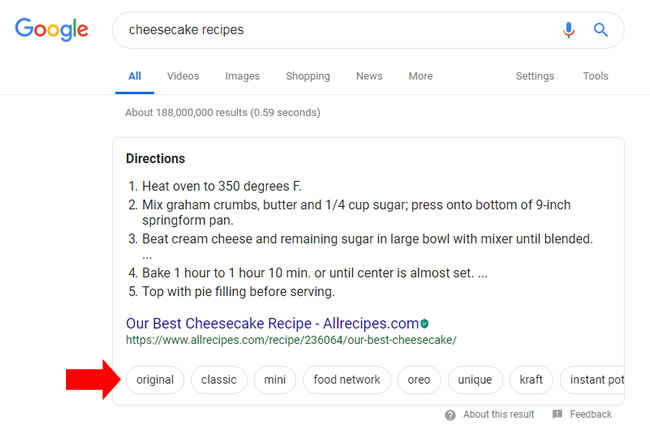
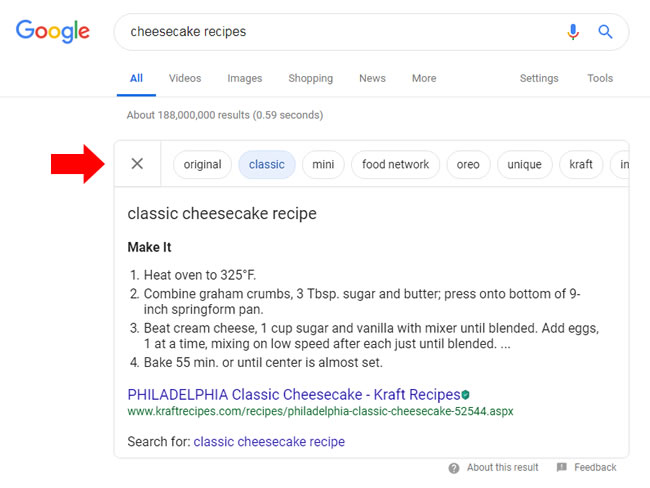
All of this would be great for site owners and SEOs to understand to help guide their content efforts. For example, which posts are yielding featured snippets, what types of content work best, which format is best, is a post ranking as a facet versus the default featured snippet, and more about the featured snippet sequence (e.g. are posts moving from the 10 blue links to a facet and then to a featured snippet?)
People Also Ask (PAA)
When searching on Google, you will often see People Also Ask modules, which contain a second level of search listings (presented in a similar format to a featured snippet). When expanding a query in PAA, you will see more information, a link to the destination site, and then an option to search Google for that query. But just like featured snippets, you will have no idea that your content is ranking in PAA modules (not from Google anyway).
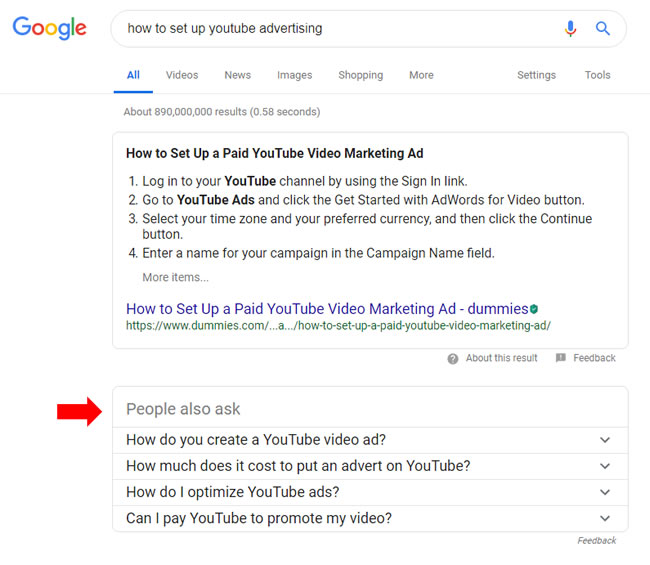
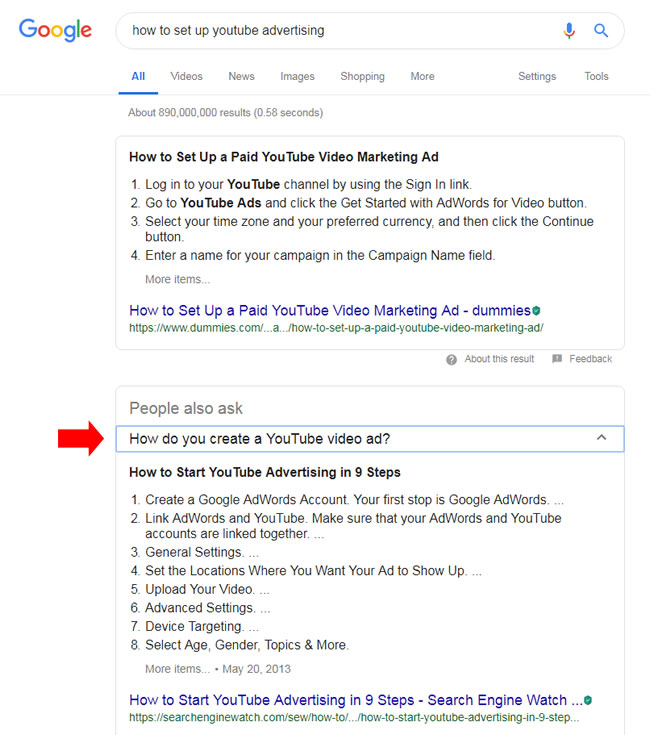
If you read my post on SEL about how Google calculates impressions, clicks, and position, then you learned that each listing in a block element will take on the position of the block. And I also explained how listings need to be revealed in order to gain impressions. So theoretically, PAA can actually make your stats look a little funny.
You might show up ranking #2 in PAA, or you might not, since the user didn’t expand your PAA listing. It’s a great reason why adding some type of tracking in GSC for PAA would be helpful. And remember, there’s a form of infinite scroll with PAA. That means your listing could have a position of 2, but it might be the 15th PAA listing. Strange, but true.
Local Pack Listings (GMB)
UTM tracking is getting killed off via the recent change announced for GSC (more on that soon). So local listings will also be harder to track via GSC now. This has been a hot topic recently, since urls with utm parameters have seen some strange reporting in GSC over the past several weeks. Impressions dropped off a cliff, while clicks remained stable. For example, notice the drop in impressions below:
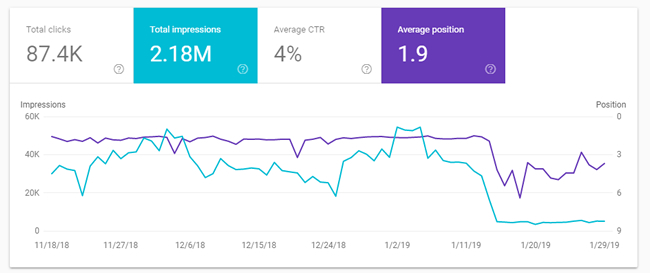
The reporting issue now makes more sense as Google announced it’s consolidating metrics in GSC to canonical urls. So for this situation, the utm urls are being canonicalized to the core urls (or will in the near-future), so their metrics will shift to the canonical urls. It’s not working perfectly yet, but that’s what is going to happen.
So, local SEOs will have no idea when their urls are showing up in the local pack, how much traffic they are driving, etc. One solution that’s been brought up on Twitter was the idea of adding a local filter to the search appearance functionality in GSC within the performance reporting. John Mueller actually liked that idea.
To me, that’s a great solution for the local issue, and for other SERP features I’ve mentioned in this post. And just like I explained earlier, definitely go and submit feedback in GSC if that’s something you would like to see. The GSC product team receives that feedback and it can help validate feedback they are receiving from other sources.
Third-party tools as a stop-gap:
Based on what I’ve explained above, I hope Google can provide some of this data in GSC. Again, I think site owners and SEOs would greatly value understanding where clicks are coming from in order to fine-tune their digital marketing efforts.
Thankfully, we have some outstanding third-party tools in the SEO industry that can at least identify when your site is ranking within certain SERP features. I won’t go too deep here, but I did want to provide a short list containing some of my favorites below. Note, you obviously can’t see traffic leading to your site via these tools, but they can help you understand when your listings are part of certain SERP features.
Which third-party tools track SERP features?
My favorite tools that enable site owners and SEOs to filter rankings by SERP features include:
- SEMrush (I’ve often called SEMrush the swiss army knife of SEO tools)
- Ahrefs
- Sistrix
- Then there are a number of dedicated rank-tracking tools that can help you surface this information as well. For example, RankRanger and STAT (now part of Moz) can surface a number of SERP features based on keywords you are manually tracking.
Again, you can’t see every query or SERP feature via third-party tools, but they can help you understand more of what’s going on in Google Land.
Summary – Seeking clarity from SERP features and Google’s ecosystem of Chrome and Feeds
As I explained in this post, context is very important. And understanding which features are driving traffic can help provide a clearer picture of traffic from Google Search, Chrome, Discover, and more. I hope this feedback reaches the GSC team and they decide to expand which features are tracked in GSC. That would be incredible and could help many site owners and SEOs better track their efforts. I’m hoping for the best!
GG
